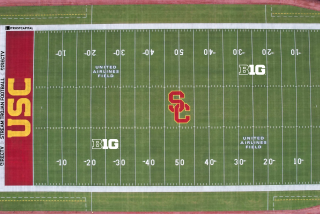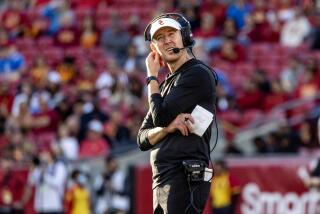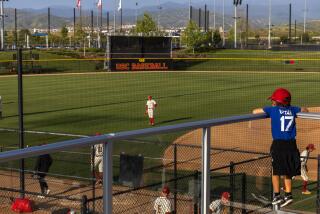Rockne’s Final Game : Always the Master Salesman, Notre Dame Coach Let USC Believe It Was Better; Then Came a 27-0 Irish Victory
Sixty years ago today, on a sunny afternoon in the Coliseum, America’s greatest football coach made his final coaching appearance.
And it was a masterpiece.
On Saturday, Dec. 6, 1930, Knute Rockne’s Notre Dame football team demolished favored USC, 27-0.
It was Notre Dame’s 18th consecutive victory. It gave the Irish--or the Ramblers, as they were also known then--their second consecutive national championship. Before a shocked, capacity crowd of 88,000, Rockne had reached the pinnacle of a coaching career to which all others are still compared.
On March 31, 1931, he died in a Kansas plane crash at age 43.
Was Knute Rockne America’s greatest coach?
He’s certainly a nominee. Sixty years after his last season, his 88% winning mark (105-12-5) is still No. 1. One of Rockne’s players, Frank Leahy (who was on his 1930 team but didn’t play against USC), is still No. 2, at 86% (107-13-9).
Only one active coach, Nebraska’s Tom Osborne, is even in the top 10. He’s ninth, at 82% (177-40-2).
One thing is certain. Rockne was the better coach in the Coliseum on Dec. 6, 1930.
It was a week when the fast-talking Rockne played the Los Angeles press corps--and, secondarily, the Trojans--like a violin. He successfully passed himself off as a coach entering an important game with no hope of victory because he was down to his third-string fullback.
And the L.A. press bought it. The Trojans bought it. Even on radio, Rockne said USC would win. Everybody bought it.
Notre Dame was 9-0. The Irish had beaten Eastern power Pennsylvania, 60-20, and powerful Northwestern, 14-0. Some called it Rockne’s best team--better even that his fabled 1924 Four Horsemen team. The Irish were unbeaten since the 1928 USC game, won by the Trojans, 27-14.
Syndicated columnist Grantland Rice had called the Notre Dame team that buried Penn “the greatest football team I ever saw.” But even Rice picked USC to beat Notre Dame, writing that it was too much to expect for even Notre Dame to beat Northwestern, Army and USC on the road on successive Saturdays. At the time the Irish played those teams, Rice pointed out, their combined records were 19-1-1.
In 1930, USC had lost its third game, to Rose Bowl-bound Washington State, 7-6, but had flattened everyone else. Howard Jones’ team, in its previous three games, had beaten California, 74-0; Hawaii, 52-0; and Washington, 32-0. Times sportswriter Braven Dyer, in his game advance, called USC “The greatest offensive machine the Pacific Coast has ever known.”
On Saturday, Nov. 30, 1930, Notre Dame had set up a Coliseum battle for the national championship. Before 110,000 at Soldier Field in Chicago, in a thunderstorm, Notre Dame beat Army, 7-6. USC, which had two weeks to prepare for Notre Dame, had shut out Washington the previous weekend.
The matchup would be the fifth game in the Irish-Trojan series, which has reached 62 meetings.
Notre Dame boarded a train in Chicago on Sunday, Dec. 1, and headed west. The night before, Rockne and his quarterback, All-American Frank Carideo, were interviewed on a radio show broadcast to Los Angeles. Bemoaning the loss of his first- and second-string fullbacks, Rockne said:
“I’m afraid we’re going to take a beating from Southern California next Saturday in Los Angeles. I am willing to wager we will not be defeated by four touchdowns, as some Los Angeles newspapermen have predicted, but if we can hold the Trojans to a two-touchdown difference we’ll go home feeling pretty good.”
An L.A. Times headline the next day said: “Knute Sees Defeat for Irish Team.”
Another read: “Battered Irish Team on Way to Los Angeles.”
Times writer Dick Hyland had sent a postcard to Grantland Rice, predicting that USC would win by four touchdowns. Rice gave it to Rockne, who showed it to his players.
At Tucson, on Tuesday, the team stopped for Wednesday and Thursday practices. One session was watched by 5,000. Half a dozen Los Angeles-area sportswriters, among them Times sports editor Bill Henry, also went to Tucson to interview Rockne.
He fed them more of the same, making much of the loss of his first- and second-string fullbacks.
When the ’30 season began, Notre Dame’s starting fullback was Jumpin’ Joe Savoldi, who in later years became a prominent pro wrestler. But at midseason, when it was learned that Savoldi had not only been married, which was not permitted then at Notre Dame, but divorced as well, he was kicked out of school.
Rockne then promoted senior Larry (Moon) Mullins of South Pasadena to the fullback job. But Mullins injured a knee against Drake and reinjured it against Army. Mullins didn’t practice in Arizona and appeared for only two token plays late in the USC game.
And so the creative Rockne endeavored to sell the idea to everyone, with a little trickery, that his players were overmatched, for lack of a fullback.
“I’m not kidding you or attempting to use psychology on the players when I say I do not expect to win,” a United Press writer quoted him as saying. “While my boys may rally enough to give the Trojans a fairly good game, I see no chance of victory. No coach could expect three victories on successive weekends over clubs the caliber of Northwestern, Army and Southern Cal.”
He told writers that with Savoldi and Mullins out of action, he would have to go with Dan Hanley, a player who had played only a few minutes all season. The writers bought that, too. Rockne even pointed to a player, who, sure enough, was wearing Hanley’s practice uniform.
It wasn’t Hanley.
The player wearing Hanley’s jersey was Rockne’s fastest player, Paul (Bucky) O’Connor, a sprinter on the Notre Dame track team--he ran 100 yards in 10.2 seconds--and normally a second-string halfback.
O’Connor, now 82, is a retired abdominal surgeon living in Hackettstown, N.J. He reminisced recently about the ’30 USC-Notre Dame game.
“Rock came up to me on the train on the way to Tucson and asked me if I could switch to fullback on short notice,” O’Connor said.
“When I told him I could, he told me to switch jerseys with Hanley at practice because he didn’t want the L.A. press or anyone from SC to know I was going to play. All the players were sworn to secrecy, too.”
Rockne figured that on Notre Dame’s short reverse plays to the fullback, O’Connor could turn what were normally short-yardage plays into big ones.
He was right.
Dec. 6, 1930: At Ralphs markets in Southern California, a pound of coffee was 22 cents. Admission to the Fox Criterion at Grand and 7th to see “Billy the Kid” with Wallace Beery and Johnny Mack Brown, was 35 cents. The Hotel Virginia in Long Beach announced that a record 358 people had eaten Thanksgiving dinner there, at $2 a plate.
And outside the Coliseum on game day, scalpers were getting $35-$50 a ticket. The Coliseum was being expanded for the 1932 Olympics, and the 88,000 who saw the game that afternoon made up the biggest Coliseum crowd to that date.
Remember, this was 1930 Los Angeles. No Dodgers, no Angels, no Lakers, no pro football, no Santa Anita, no Hollywood Park. The Trojans owned Los Angeles. But by late afternoon, Knute Rockne owned L.A.
When the Trojans trotted out of the Coliseum tunnel and onto the field for pregame drills, they were greeted with a roaring, standing ovation. It was their last hurrah.
Notre Dame received the opening kickoff and drove 60 yards to the USC 20, where Carideo misfired on a fourth-down pass. On USC’s first play, center Stan Williamson’s snap was too low, causing a fumble. Notre Dame tackle Al Culver recovered at the 19.
On first down, quarterback Carideo, on a double pass play, caught a throw at the seven from All-American halfback Marchie Schwartz and scored untouched.
Then late in the first quarter, after USC had punted into Notre Dame’s end zone, Rockne unleashed O’Connor. On first down at the 20, O’Connor burst through the line and ran 80 yards. Notre Dame had a 13-0 lead.
The Trojans, who had averaged 535 yards of offense a game, crossed the 50-yard line twice that afternoon. The 5-foot-8 Carideo, in his final game, was brilliant. Notre Dame out-rushed USC, 331-89. O’Connor had 119 yards in 10 carries. In total offense, Notre Dame prevailed, 428 yards to 146.
“The reverse plays to O’Connor keyed the whole game for us,” Carideo recalled. He’s now an 82-year-old retired coach in Ocean Spring, Miss. “Bucky was a sprinter, and on his long run he was through the USC line before they could get a hand on him. Rock just knew those plays would work.”
On the next Wednesday morning, when Notre Dame’s train reached Chicago’s La Salle Street Station, a wild welcome ensued.
Notre Dame fans ran up and down the roofs of the cars. Police had to clear the mob away from the cars and form a tunnel so the players could reach their cars. There was a parade, and ticker-tape rained on the team in the city’s financial district.
The parade ended where it had begun, at the station, where the team boarded another train for South Bend, Ind.
Knute Rockne’s final parade was over.
More to Read
Go beyond the scoreboard
Get the latest on L.A.'s teams in the daily Sports Report newsletter.
You may occasionally receive promotional content from the Los Angeles Times.






